
Reaching out to the Past
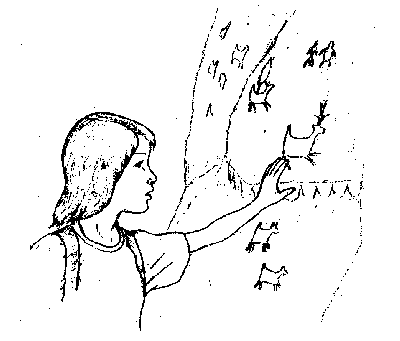
While hiking with her family in the Black Hills, nine-year old Tracy lagged behind, looking at the cliff next to her. She was astonished to see that someone had carved images of animals and people on the face of the stone. They looked very old. She reached out to touch them, and, as her fingers brushed the stone, the ancient peoples of South Dakota reached out to touch her in turn...
Archaeology
The prehistoric and historic peoples of South Dakota are all around us, and they speak to us in different ways. The most recent of our ancestors have left us their traditions and written histories, and we feel we know them very well. Ancient peoples, though, left us no written history. They are only shadows to us, dim and hard to understand. They have left us a message in the earth in the remains and ruins of their homes, camps, workplaces, and towns.
Archaeology is our way of reading that message and understanding how these peoples lived. Archaeologists take the clues left behind by the people of the past, and, like detectives, work to reconstruct how long ago they lived, what they ate, what their tools and homes were like, and what became of them.
Archaeologists learn these things from the study of what people have thrown out or left behind stone tools such as arrowheads and scrapers, animal bones, seeds and charcoal, pottery, glassware, and old cans, for instance. Archaeologists also study more complex remains such as fire hearths, storage pits, earthlodges, rockshelters, and root cellars.
The South Dakota Story
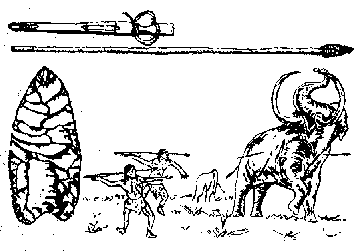 No one knows for sure when the most ancient ancestors of Native Peoples—known to archaeologists as Paleoindians—came to the Americas. We do know that by 13,000 years ago, as the Ice Age came to a close, the Clovis peoples had taken up residence in what would become South Dakota. At many Clovis sites, archaeologists have unearthed the remains of the now-extinct animals they hunted, including mammoths, mastodons, horses, and American camels. Clovis hunters killed and butchered two mammoths at a site located on what is now the Pine Ridge Indian Reservation.
No one knows for sure when the most ancient ancestors of Native Peoples—known to archaeologists as Paleoindians—came to the Americas. We do know that by 13,000 years ago, as the Ice Age came to a close, the Clovis peoples had taken up residence in what would become South Dakota. At many Clovis sites, archaeologists have unearthed the remains of the now-extinct animals they hunted, including mammoths, mastodons, horses, and American camels. Clovis hunters killed and butchered two mammoths at a site located on what is now the Pine Ridge Indian Reservation.
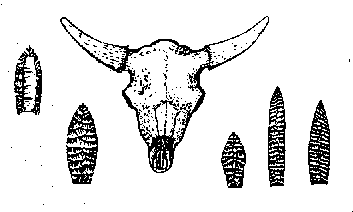 Changing times and circumstances call for changes in the way people live. About 11,000 years ago the great Ice Age animals had become extinct, and Paleoindian hunters adapted their techniques to other game the giant long-horned bison which were common at the time, initiating a long relationship between them. The distinctive Clovis stone spear point was replaced by the elegant Folsom point, which marks some of the finest stone tool work ever done by humans anywhere. Folsom points have been found at several places in South Dakota.
Changing times and circumstances call for changes in the way people live. About 11,000 years ago the great Ice Age animals had become extinct, and Paleoindian hunters adapted their techniques to other game the giant long-horned bison which were common at the time, initiating a long relationship between them. The distinctive Clovis stone spear point was replaced by the elegant Folsom point, which marks some of the finest stone tool work ever done by humans anywhere. Folsom points have been found at several places in South Dakota.
Approximately 10,000 years ago the Folsom hunters too had passed on, and succeeding generations of Paleoindian hunters showed greater and greater regional variation. The giant bison continued to be the primary game animal, but people shifted to using other types of spear or dart points, known to archaeologists now as Agate Basin, Hell Gap, Eden, Angostura, and others. Several sites of these Plano complexes, as archaeologists call them, are known in South Dakota.
All of this had taken place during a time of relatively warm, comfortable climate in South Dakota. About 7,000 years ago the climate became drier, droughts lasted longer and came more frequently. The lifestyle practiced by the big-game hunting Paleoindians gave way to a more flexible hunting and gathering pattern. When buffalo were plentiful, they shifted to reliance on the hunt. In drier times they concentrated on smaller game (even rodents). By this time, plant foods had become very important to the diet of the peoples perhaps more important than hunting. People appear to have lived in very small groups most of the time, not unlike the peoples of the Great Basin in recent times.
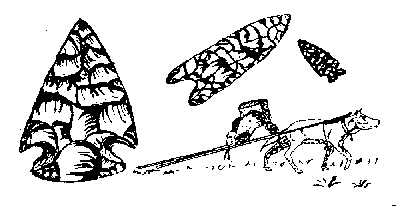 The time after 7,000 years ago is known as the Plains Archaic period in South Dakota. The dry climate slowly improved, and by 3,000 years ago (about 1000 B.C.) conditions were much the same as today. Bison hunting became more practical on a regular basis. The shift is most often seen in the adoption of corner-notched dart points known as Pelican Lake points. People regularly came together in larger bands for large-scale bison hunts involving elaborate drives, jumps, or traps.
The time after 7,000 years ago is known as the Plains Archaic period in South Dakota. The dry climate slowly improved, and by 3,000 years ago (about 1000 B.C.) conditions were much the same as today. Bison hunting became more practical on a regular basis. The shift is most often seen in the adoption of corner-notched dart points known as Pelican Lake points. People regularly came together in larger bands for large-scale bison hunts involving elaborate drives, jumps, or traps.
Contact to the east became apparent in eastern South Dakota by the end of the first millennium B.C. Prehistoric peoples along the Missouri and other major rivers and lakes adopted the art of making pottery. We know that social and religious changes were underway by the fact that hundreds and hundreds of burial mounds were constructed, providing more elaborate means of burying the dead. Trade goods from other regions are also more common in the villages of these peoples, implying contacts with other cultures over a broad area. This marks the beginning of what archaeologists know as the Woodland period. In western South Dakota the Archaic period lingered on, but with increasing signs of contact with the Woodland peoples in the east. Reliance on hunting bison and plant gathering was still the rule throughout the state. A major technological innovation appeared in this period. The bow and arrow came into use about A.D. 500, and the old dart points were quickly replaced by smaller chipped stone arrow points.
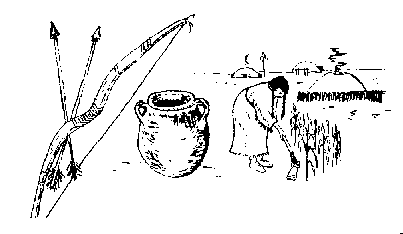 The next major change in the prehistoric cultural mosaic of South Dakota came after A.D. 900. Farming peoples appeared, at first in the southeast part of the state. These people not only hunted and gathered plant foods, but they also cultivated crops of corn, beans, squash, and sunflowers in gardens along the river bottoms. They lived part of the year in insulated earthlodges in large villages fortified by ditches and log palisades. By A.D. 1500 the Plains Village peoples were living all along the Missouri River valley, and their hunting camps are known from much of the rest of the state.
The next major change in the prehistoric cultural mosaic of South Dakota came after A.D. 900. Farming peoples appeared, at first in the southeast part of the state. These people not only hunted and gathered plant foods, but they also cultivated crops of corn, beans, squash, and sunflowers in gardens along the river bottoms. They lived part of the year in insulated earthlodges in large villages fortified by ditches and log palisades. By A.D. 1500 the Plains Village peoples were living all along the Missouri River valley, and their hunting camps are known from much of the rest of the state.
It is likely that the bison-hunting peoples of earlier times still lived to some extent in western South Dakota, and Woodland people still made their living along the lakes of eastern South Dakota. A second culture, called Oneota by archaeologists, moved into eastern South Dakota during the middle part of the second millennium A.D. These people were distant cultural cousins of the earliest Plains Village peoples in South Dakota. They practiced a mixed economy of hunting, fishing, plant food gathering, and garden farming.
All these earliest South Dakotans are known to us only by the artifacts and abandoned remains of their camps and villages. After A.D. 1700 or so the earliest signs of European contact begin to appear in the artifacts of the inhabitants items such as glass trade beads, iron knives, and other metal implements. The horse also appears, traded northward from the Southwest. The combination of horse and later gun transformed the lives of the Plains hunters in South Dakota, ultimately giving rise to the horse-mounted cultures so familiar to all Americans.
The early maps of the European and American explorers allow us finally to put names to some of the inhabitants of that era. The Plains Village peoples emerge into history as Mandans, Arikaras, and Hidatsas. The western peoples include the Crows and Cheyennes, among others. The peoples of eastern South Dakota are seen to be the Omahas, and Poncas, and Dakotas, with the latter people expanding statewide during the 1700s.
The Euro-American expansion into South Dakota is historically documented, but there is much we do not know about the lives of these early peoples, either. Archaeologists have unearthed artifacts at early trading posts, military forts, farmsteads, mines, and even towns in their search to fill in the gaps of what is known about this period of our history.
South Dakota's past is truly a fascinating mosaic of peoples, lifestyles, sweeping changes, and enduring traditions.
The Archaeological Research Center
The Archaeological Research Center is deeply involved with all aspects of South Dakota's archaeology. The Center is a program of the South Dakota State Historical Society of the S.D. Dept. of Tourism and State Development. It is also the Office of the State Archaeologist. Originating as part of the University of South Dakota Museum in the early twentieth century, the Center was split off as a separate agency when state government reorganized in 1973. It has conducted excavations at dozens of prehistoric and historic sites all over South Dakota and houses collections from thousands of archaeological sites. These collections are used for research, teaching, and exhibits not only in South Dakota but also surrounding states.
The Center conducts research programs for agencies requiring archaeological work as part of their missions, including agencies such as the S.D. Department of Transportation and the S.D. Department of Natural Resources. It also cooperates with other agencies and institutions in South Dakota in the ongoing efforts to preserve our past.
What can you do?
If you would like to participate in the discovery of South Dakota's past, both ancient and recent, the Archaeological Center, along with other agencies and institutions around the state, has various programs for public involvement. Excavations are offered most summers to members of the public at various sites. Lectures and other programs are available for scouts, schools, and other groups desiring to know more about archaeology.
Classes are also available at several of the state's educational institutions. Each summer the Center and other institutions sponsor Archaeology Days at various localities around the state. Finally, the South Dakota State Archaeological Society provides not only newsletters and journals to its members, but also fellow enthusiasts who share a common interest in our heritage.
Further Reading
Prehistoric Hunters of the Black Hills by E. Steve Cassells. Johnson Books, Boulder, Colorado, 1986.
Prehistoric Hunters of the High Plains, 2nd edition by George Frison. Academic Press, New York, 1991.
Archaeology on the Great Plains edited by W. Raymond Wood. University of Kansas Press, Manhattan, Kansas, 1999.
Peoples of Prehistoric South Dakota by Larry J. Zimmerman. University of Nebraska Press, 1985.
Reach us
Archaeological Research Center
P.O. Box 1257
937 E. North St., Suite 201
Rapid City, SD 57709-1257
Ph. 1-605-394-1936
Fax 1-605-394-1941
Or reach the Historical Society at...
South Dakota State Historical Society
900 Governors Drive
Pierre, SD 57501
Ph. 1-605-773-3458